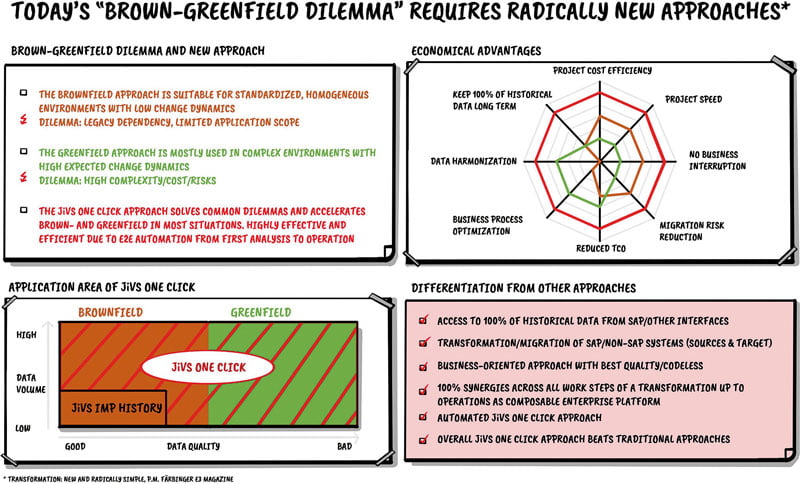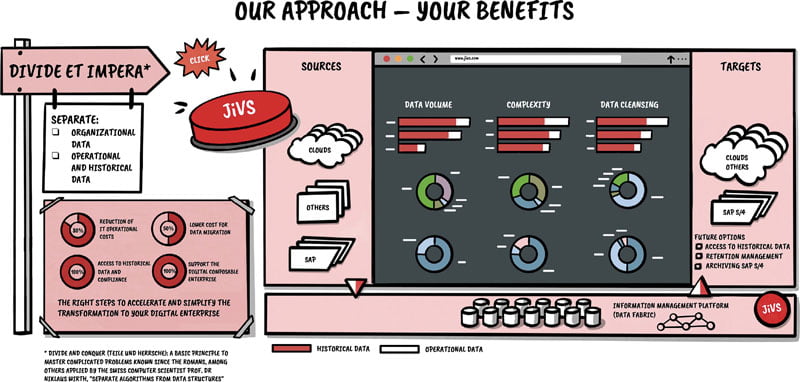Money or just straw after all?


It's like the Grimm Brothers' fairy tale Rumpelstiltskin: The board of directors demands the impossible from its IT department. It should spin straw into gold like the poor miller's daughter. The managers know, of course, that this is impossible. But like the king to the miller, they want to believe the fairy tale that their IT has magical powers.
Poor miller's daughter. Of course, the data is available. But in a wide variety of formats, in a wide variety of memories and in a wide variety of quality. And thanks to cloud services and the Internet of Things, new data formats and sources are constantly being added. IT departments have tried in the past to provide and analyze data for their bosses for process and business control. Since then, they know that this task is almost impossible to accomplish.
"It's like a Sisyphean task".Thomas Failer knows from many years of consulting experience. He is founder and CEO of Swiss-based Data Migration International, whose business is enterprise information management. He says: "Whenever the data experts had built the interfaces to the various data sources and defined the transformation rules, the business had already made changes again. The data they had painstakingly collected for business control was therefore already outdated by the time they evaluated it."

Death in silo
However, the time gap is only one problem that companies must eliminate on the way to data control. Equally obstructive is the fact that important information is necessarily always lost when data and its structures are harmonized. But this information is essential for analysis and control. To understand why customer revenues are declining, it is not only the declining revenues that are important. Those only describe that a company is selling less, not why. The reasons are more likely to be found in customer correspondence, which is linked to sales. But if the data is separated from the context and stored in archives and the like, business leaders are missing precisely the critical information.
"It's no wonder so many business management data projects fail or don't produce the results decision makers hope for", explains Thomas Failer. The trick is to preserve the data along with its context and make it available for analysis and insights and to optimize it. But that's not so easy. Because there are major dependencies between the data, its structures, and the systems and applications in which they were created.
These dependencies are like the walls of a silo. And there are a lot of them, especially in large and very large companies. The CIOs of this republic have invested a lot of time and money in recent years to tear down these walls. "Also with the help of the cloud"stresses Thomas Failer. "But in doing so, they found that they were creating new silos for themselves. That's dangerous. Haven't we all read somewhere how people have met their death in a silo?"
On the one hand is the context that makes the data as valuable as oil. On the other hand, it's the dependencies that add straw to the oil. And then there's the legislature. Various retention obligations and deadlines prevent companies from changing data and its structures as they see fit.

"The problem is pervasive. But boards usually don't address it until there's a generational change in core enterprise applications, such as ERP."Thomas Failer knows from his own experience. He began his career as a consultant during SAP migrations from the mainframe version R/2 to the client-server architecture R/3. "Companies wanted to take all the information with them into the new world, but to do so they had to change its structure. At the same time, they had to find a solution for keeping this information unchanged. But that was only possible with the help of the legacy system, which they therefore continued to operate until the legal deadlines had expired. This is exactly what is happening again with the switch to S/4.
Trench warfare
The continued operation of legacy systems is costly. To save time and money, IT massively restricts access to them. This, in turn, is a serious nuisance to colleagues from the specialist departments, but especially to the CFO. They believe that it is best to have access to the entire database at all times and not just during internal audits or audits by the tax office.
In many companies, bitter trench warfare rages between these two extreme positions. And even where there is a will to reach agreement, the situation resembles haggling among merchants. IT says: "I'll give you access to the past three years of data." The CFO roars: "But I want ten years!" And in the end, they agree on five years. This is not what rational decisions look like.
The worst thing about it is that Rumpelstiltskin is still up to his tricks. Because every lazy compromise means - actually or figuratively - night shifts for IT. Even five vintages of legacy data correspond to huge amounts of data in large companies. The fact that the CFO and business departments can use them in the new system does not justify the associated effort for transformation and migration.
"This is a very bad deal that companies are making", Thomas Failer judges, because: "Transformed legacy data also drags past dependencies into the new systems. Companies are limiting themselves by doing this and foregoing much of the innovation potential of new generations of software."

Management wants to modernize and digitize business models and processes. When switching to SAP S/4, this means cutting old ties and returning to the standard SAP specifies. This includes reducing individual customizations to a minimum and rebuilding them as needed. Many of these originate from the past and simply no longer make sense today.
Even management decisions that are now commonplace, horse-trading in legacy data makes it a real problem for IT. These include, for example, acquisitions and disposals of companies and business units. It is difficult to impossible to extract and transfer exactly the information that buyers and sellers are allowed and required to have in a highly individualized SAP system with a data inventory of 20 years or more. It is just as difficult to take off with this legacy in your luggage after the changeover to S/4 Hana thanks to new processes and by means of data control.
Business case sought
Although the end of support is fast approaching in 2027 and 2030 at the latest, 75 percent of SAP users in German-speaking countries continue to operate the SAP ERP and SAP Business Suite solutions, according to the DSAG Investment Report 2022. And just under half of those using S/4 on-premises continue to run their old SAP systems in parallel.
"This is not a miracle"says Thomas Failer. In his view, companies are still looking for the business case for the changeover under the given conditions. He is convinced: "It is most likely to pay off for start-ups and companies that are completely turning their business model upside down. Then the legacy data can stay where it is. The companies then start anew with an empty SAP S/4." All others, however, are confronted with the bad alternative: complete or partial transfer of business objects, individual adjustments, and data and its structures as in the legacy system. This is technically feasible, but forces companies to forego innovation. Nothing but expenses.
This is unacceptable at a time when the pressure to change due to pandemics, wars and geopolitical upheavals is greater than ever and keeps IT teams on their toes. Paradoxically, this is precisely why companies are putting off the necessary switch to the new software generation from Walldorf.
This is all the more regrettable because the potential is enormous. "SAP legacy customers only need about 10 percent of the dataset for processing in the new S/4 world, only about half of the business objects, and about 20 percent of the previous document types"Thomas Failer knows. However, this major cleanup will only succeed if the basic problem of handling legacy data is solved. He also knows how: "The solution is to separate the level of data from the applications and outsource the data from the legacy systems unchanged on a separate platform."
The crucial difference to an archive is that the business context is also outsourced and retained. In addition, the platform concept is essential. After all, it's not just about audit-proof long-term storage to meet legal requirements. To enable companies to manage their information independently of legacy applications and systems, a platform must include many different functions for a wide variety of scenarios. Like a smartphone that is a camera, phone, music player and much more all in one.
And yet it exists
With such a device, managers can support a wide range of business cases: a fast and lean transformation and migration to SAP S/4 and return to SAP standard; acquisitions and divestments of companies and parts of companies; the complete decommissioning of legacy systems, not just their dismantling; consolidation of data centers and IT environments; permanently lean S/4 Hana systems; migration to the cloud and back again; and last but not least, analytics and data governance.
"We know from more than 2,000 projects worldwide that decommissioning legacy systems reduces costs by 80 percent or more compared to keeping them in operation. Data transformation and migration efforts are reduced by half. And we expect total cost of ownership to drop by a quarter when companies keep S/4 Hana lean using our platform for the long term."Thomas Failer calculates. "Here it is, the long-sought business case for moving to S/4."
The most important technical feature of the platform is its high degree of automation: from the extraction of data from the legacy systems and its harmonization and optimization, to the transformation and migration of business objects via the application layer, to the automatic transformation to display the historical information in S/4 as if it had been generated there. Then it also works with the CFO.
"We call this One-Click Transformation and have successfully applied for a patent for our approach. We are thus opening up a completely new dimension in terms of digital transformation in general and the move to S/4 Hana in particular.", Thomas Failer proudly reports and adds: "We are currently expanding our concept in the direction of transformation as a service. To this end, we have developed a software-as-a-service solution."
The idea behind this cloud service is that companies can run through and prepare their planned transformation projects with just a few mouse clicks. To do this, they do not have to reveal any real data from their systems. Instead, the service works with metadata such as details of systems, applications and databases used by a business unit that is up for sale.
With the help of the service, companies can quickly determine what data needs to be handed over to the potential buyer and in what quantity, and define the necessary filter criteria for this. If the data extraction and transfer is then actually to take place, they simply adopt these filter criteria and apply them to Thomas Failer's platform.
Oh how good that everyone knows
"But it need not and should not stop there. Because the preparatory work that a company has done for this scenario can be reused. For example, for the dissolution of a data center site or for the transformation to SAP S/4. With our service, companies achieve economies of scale in their transformation projects and can further simplify and accelerate them."explains the inventor of the JiVS IMP platform.
In Grimm's fairy tales, it is the name of the ugly, tireless and ultimately life demanding dwarf who makes the king and the miller's daughter find happiness. In real life, companies can banish Rumpelstiltskin from their organization once and for all with One-Click Transformation and Transformation-as-a-Service from Data Migration International. Good thing more and more managers know the secret.






